Key takeaways:
- Storyboarding is essential for visualizing narrative flow, enhancing emotional depth, and improving collaboration among the film crew.
- Key elements of an effective storyboard include clarity, emotional detail, and flexibility to adapt during production.
- Avoid common mistakes such as neglecting emotional tone, overcrowding visuals, and ignoring scene transitions for a cohesive narrative.
- Embrace iteration and collaboration, continually refining storyboards to enhance storytelling through diverse perspectives.
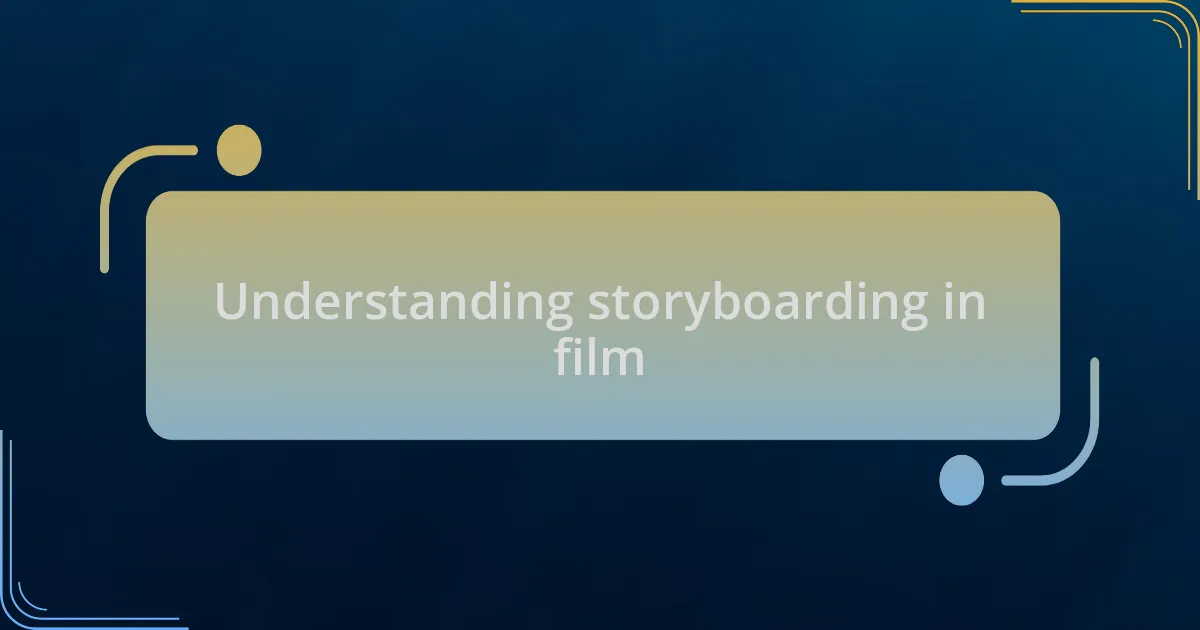
Understanding storyboarding in film
Storyboarding is much more than just sketching out scenes; it’s a visual roadmap for the entire film. When I first started in film production, I underestimated the power of a well-crafted storyboard. I remember one of my early projects where we jumped into shooting without one, thinking we could figure it out on set. The chaos that ensued taught me that a storyboard serves as a crucial blueprint, guiding the crew and ensuring everyone is on the same page.
The emotional impact of storyboarding can’t be overstated. Each frame encompasses not just actions but also emotions and atmospheres that should resonate with the audience. I distinctly recall a time when a storyboard I created allowed us to visualize a character’s internal struggle on screen. That clarity made it easier for our actors to connect with their roles, elevating the entire performance. Have you ever considered how a storyboard could transform raw ideas into a cohesive narrative?
Another important aspect of storyboarding is its role in collaboration. As I’ve navigated various projects, I discovered that sharing storyboards with the team fosters open communication. It enables everyone, from the director to the cinematographer, to contribute their insights and perspectives early in the process. This collaborative spirit not only enriches the creative output but also builds camaraderie, as we work towards a shared vision. Have you thought about how this collaboration impacts your own projects?
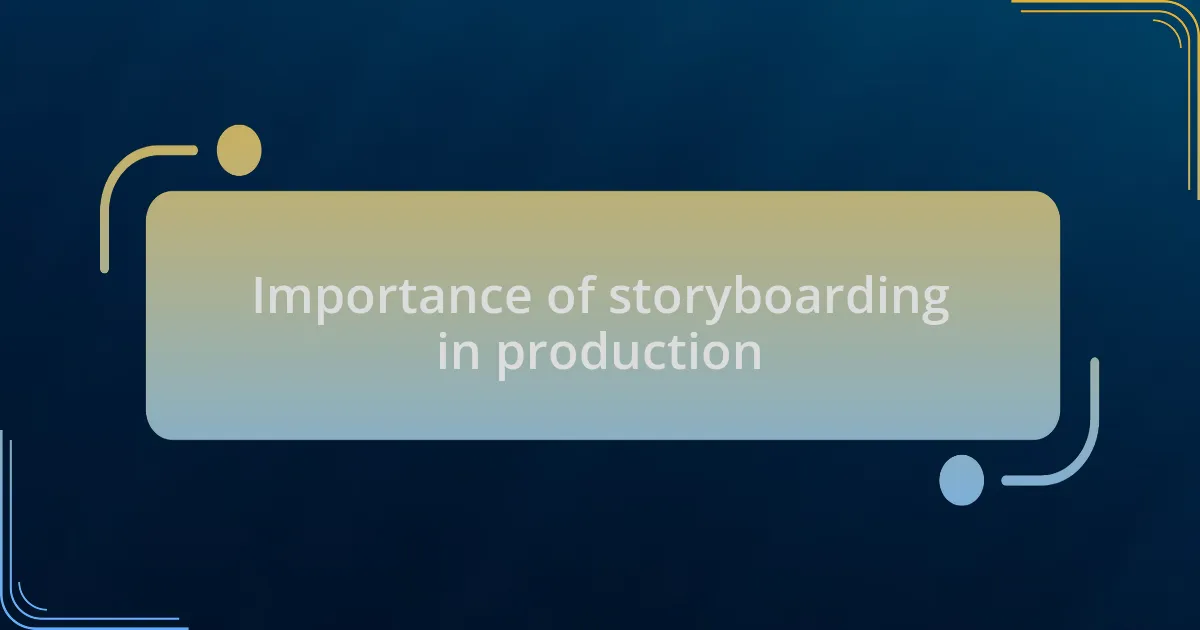
Importance of storyboarding in production
Storyboarding plays a pivotal role in visualizing the narrative flow of a film. On one of my recent projects, I found that sharing a storyboard with the team allowed us to identify pacing issues early on. We could manipulate scene sequences effectively, which not only saved time but also sparked innovative ideas I hadn’t initially considered. Why wait for the editing room to see if the story flows when you can visualize it beforehand?
Another significant aspect I’ve noticed is how storyboarding minimizes miscommunication. During a shoot where we had a tight schedule, having a clear storyboard meant everyone was aligned on their individual tasks. I remember a specific scene that required intricate choreography between characters. Without a storyboard, it would have been nearly impossible to nail those nuances on day one. Isn’t it reassuring to know that a simple visual guide can prevent costly mistakes?
Moreover, a well-prepared storyboard allows for flexibility and experimentation. On a different occasion, I was able to adapt scenes based on how the actors interpreted their characters. The initial storyboard served as a solid foundation, but I could rewrite certain frames on-the-fly, enhancing the natural spontaneity of the performances. Don’t you think a balance between structure and creativity is essential in storytelling?
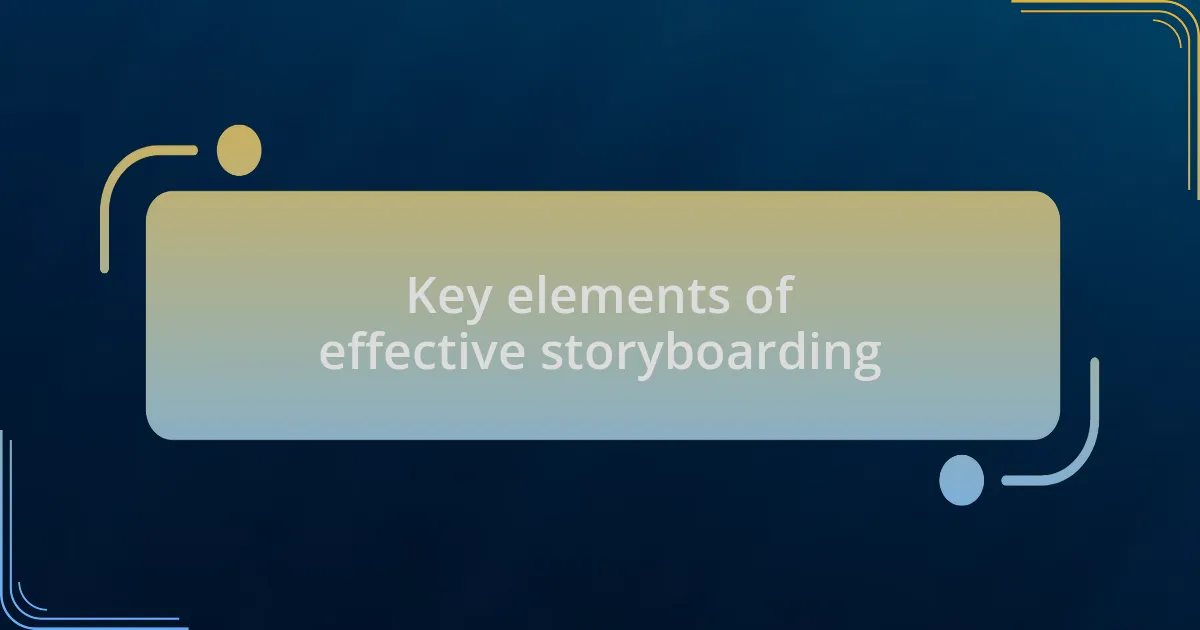
Key elements of effective storyboarding
When I think about the key elements of effective storyboarding, the first thing that comes to mind is clarity. A storyboard should communicate the visual sequence without ambiguity. I recall a time when our team was left scratching our heads over vague sketches. It wasn’t until we clarified the details that everything clicked into place. Have you ever struggled with misinterpretations? Clear visuals help avoid that frustration—everyone knows exactly what’s expected.
Another important aspect is detail. I’ve learned that incorporating emotional cues in my storyboards can steer the tone of the film. One of my best memories is crafting a frame where the subtle expressions of the characters spoke volumes. It transformed the mood entirely and led us to capture a performance that resonated deeply with audiences. Isn’t it fascinating how much can be conveyed in a single image?
Finally, flexibility is crucial. I distinctly remember a project where we hit a creative roadblock mid-shoot. Thankfully, having a rough storyboard allowed us to brainstorm new approaches without losing sight of our goals. We shuffled scenes around, added shots, and suddenly, the narrative felt cohesive again. Isn’t it interesting how structure can coexist with spontaneity? Embracing adaptability not only fosters creativity but also enhances the collaborative spirit on set.
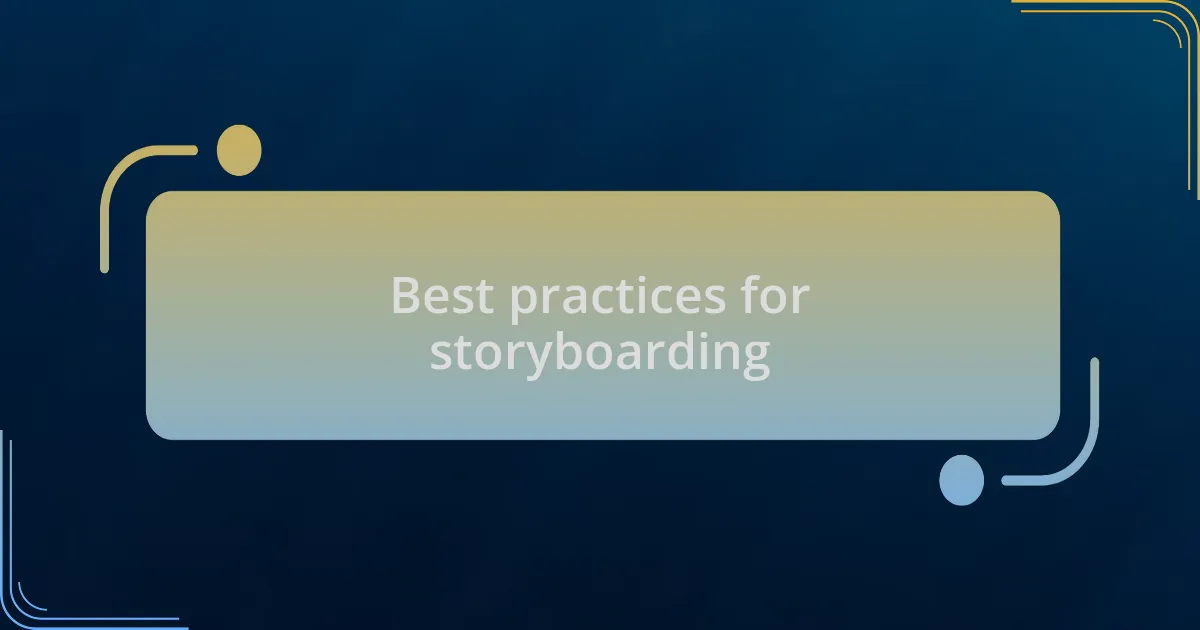
Best practices for storyboarding
The best practice I’ve adopted is starting with a clear vision before picking up the pencil. When I first embarked on storyboarding, I often jumped straight into sketching without fully mapping out the narrative arcs. It wasn’t until I took time to outline the key scenes and their emotional beats that my storyboards truly began to resonate. Have you ever plotted out scenes and then felt the storyboard come alive? It’s an exhilarating process.
In addition to that initial vision, I’ve found that collaborating with the team while storyboarding is invaluable. I remember collaborating with my cinematographer on a recent project, and sharing our ideas opened up avenues I hadn’t considered. By discussing each scene and pooling our insights, our storyboards evolved into a shared visual language. Could you imagine how different the final product would have been with just one perspective? The result was a storyboard that felt unified and enriching, reflecting the diverse creative energies of the team.
Lastly, always be willing to iterate. My early drafts would often look nothing like the final storyboard, and that’s okay! In one project, we changed a character’s journey entirely, and my willingness to revisit and refine the storyboard played a crucial role in that shift. It reminded me that we should see storyboarding not as a chore but as a fluid exploration of the narrative. Doesn’t it make sense to embrace change and enhance our storytelling along the way? By staying open to adjustments, we ensure that our stories can grow and evolve into their best forms.
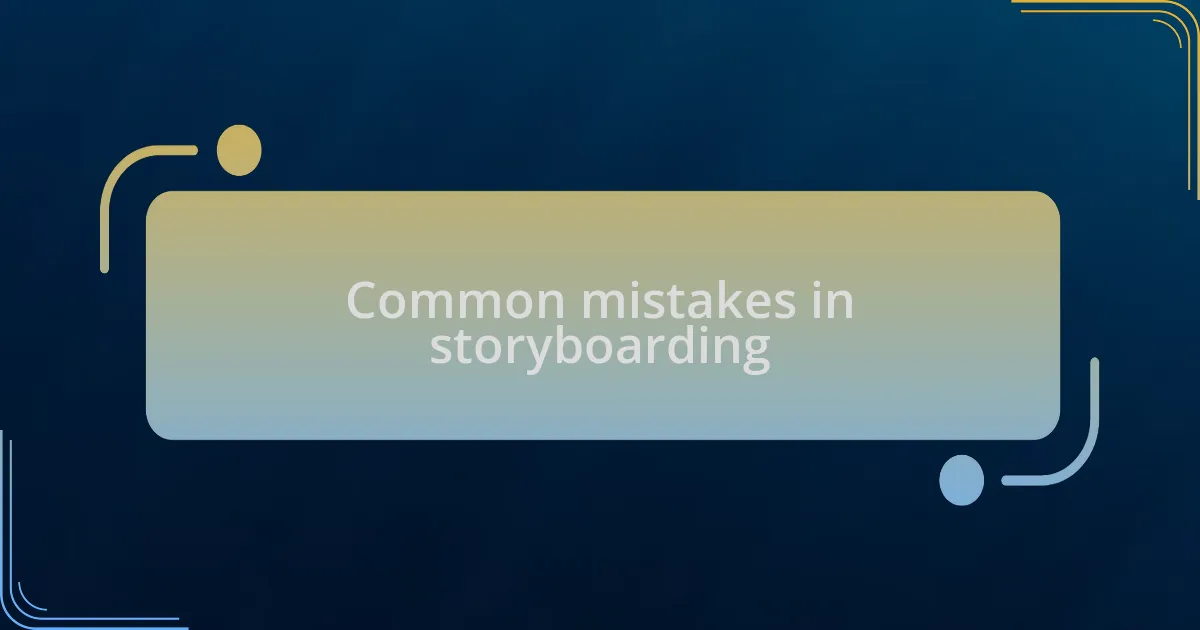
Common mistakes in storyboarding
One common mistake I often see in storyboarding is neglecting to show the emotional tone of a scene. Early in my career, I made the error of focusing solely on action without capturing the characters’ emotional states. This oversight resulted in storyboards that felt flat and disconnected. Have you ever watched a scene where the visuals didn’t match the intended emotion? It’s jarring, and I learned that infusing emotion into each frame can truly elevate the narrative.
Another frequent pitfall is overcrowding the storyboard with unnecessary details. I once created a storyboard that was so packed with elements that it became overwhelming, losing the essence of the story in the process. It’s easy to get caught up in the specifics, but I’ve realized that simplicity is often more powerful. What if we stripped down the visuals to focus on key actions and emotions? The clarity that comes from a less-is-more approach can truly highlight the core of the story.
Lastly, failing to consider transitions between scenes can derail the flow of the narrative. I remember a project where I didn’t pay enough attention to how one scene flowed into the next. The final result felt choppy, and audience engagement suffered. Reflecting on that experience, I’ve learned that integrating transitions into storyboards can create a seamless journey for the viewer. Isn’t it fascinating how a little bit of foresight can make such a significant difference?
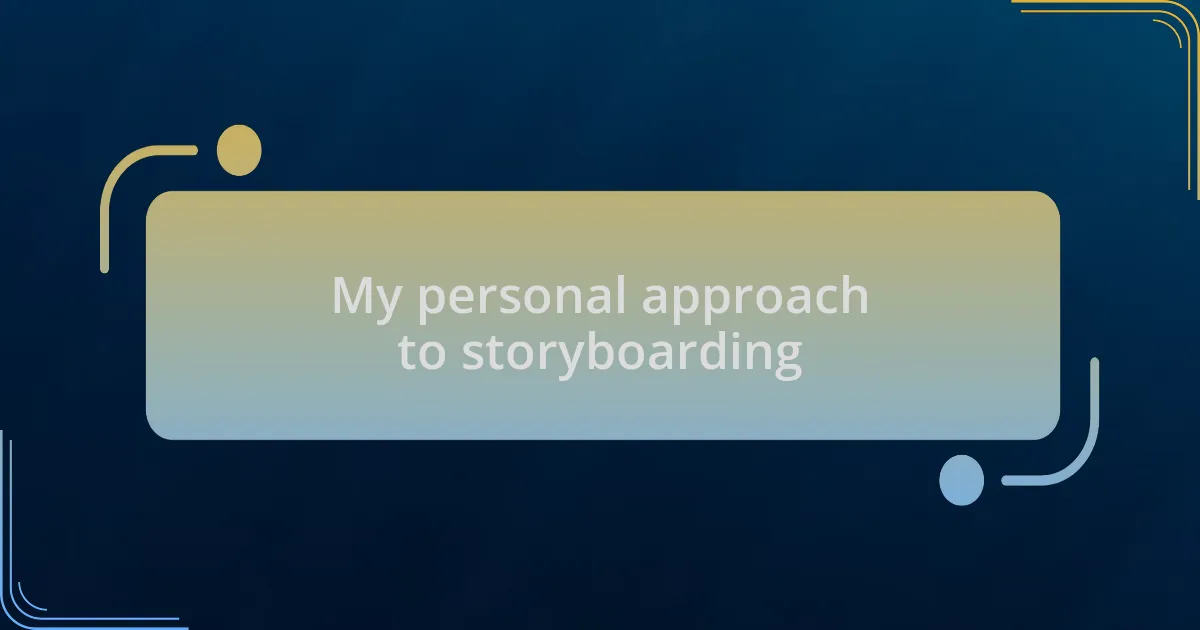
My personal approach to storyboarding
When I approach storyboarding, I start by visualizing the emotional landscape of the entire project. For instance, during my last film, I sketched a scene while feeling the protagonist’s despair. It was a powerful moment that shifted my perspective on how crucial emotional depth is to storytelling. How can we expect our audience to connect if we don’t first engage with those emotions ourselves?
As I lay out each frame, I often consider the rhythm of the narrative. There was a time on set when I realized that the pacing of the storyboard I created didn’t match the actual tempo of the shooting. It prompted me to rethink how elements flowed together visually and timing-wise. Bringing that rhythm into the storyboard is like composing a piece of music. Can a storyboard truly sing if it lacks that careful attention to pace?
Moreover, I find that keeping an ongoing dialogue with my team enhances the storyboarding process. Early on in my career, I would often work in isolation, which led to a disjointed vision. I’ve embraced collaboration now, often sharing my drafts to gather feedback. Every time I hear a fresh perspective, it’s like a light bulb goes off, revealing new dimensions. Isn’t it remarkable how collective insights can refine and enhance our creative efforts?
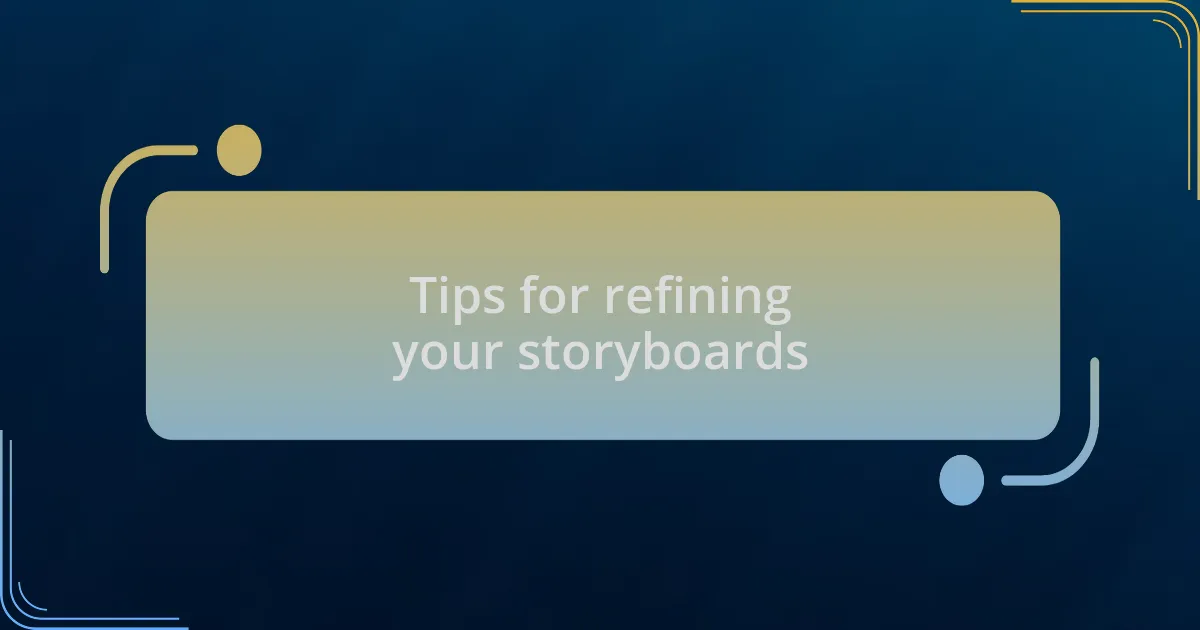
Tips for refining your storyboards
One effective tip for refining your storyboards is to embrace the art of iteration. I’ve found that the first version of a storyboard rarely captures everything I envision—it often serves as a skeleton. During one project, I would print out my initial sketches and cover the walls of my workspace with them. Walking through the scenes as if I were on set allowed me to visually and emotionally connect with the flow. It’s fascinating how stepping back can reveal inconsistencies or spark new ideas. Have you ever tried revisiting your work with fresh eyes?
Another key strategy is to prioritize clarity over detail. In my experience, overly intricate drawings can detract from the core message I want to convey. I vividly recall a time when I spent hours perfecting a single frame only to realize that my team struggled to grasp its purpose. Simplifying those visuals allowed us to focus on what truly mattered—the story itself. So ask yourself: Does every detail add value to the narrative? If not, it might be time to consider streamlining.
Lastly, don’t shy away from integrating different perspectives into your storyboarding. I remember collaborating with a cinematographer who had a unique approach. He suggested framing techniques that altered my vision entirely, breathing new life into scenes I thought were already solidified. This experience reinforced a vital lesson: incorporating voices from various disciplines can deepen the storytelling. How often do we limit ourselves by not inviting diverse insights? Embracing collaboration can not only elevate your storyboard but also enrich the entire production process.